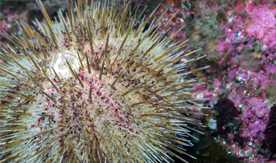Bulking Up

Enhancing green sea urchin egg production to aid Maine’s depressed urchin market is the research focus of a University of Maine marine bioresources graduate student.
Ung Wei Kenn, a second-year master’s student from Kuala Lumpur, Malaysia, hopes to increase the egg or roe yield of farm-raised green sea urchins through high-quality feed, a process known as bulking. His research is part of a two-year, more than $215,000 research project funded by the National Sea Grant National Strategic Initiative and led by director Nick Brown and biologist Steve Eddy of UMaine’s Center for Cooperative Aquaculture Research (CCAR) in Franklin, Maine.
“I was always interested in the vertical integration of aquaculture and seafood processing,” says Ung, who completed his undergraduate work at the University of Tasmania, Australia. “I am also passionate about seafood that is popular in Asia. This topic is a blend of all that.”
Ung came to UMaine because he was attracted to the project, but he praises CCAR, where he conducts his research, as a key part in his decision to work at UMaine.
“I always felt that aquaculture is not just a science; it is a business as well,” says Ung. “CCAR is special in that it is specifically set up to assist aquaculture businesses by providing scientific and technical know-how. I would not have this luxury at most other places.”
Ung’s research potentially could have significant economic benefit for the state. Maine exports roe to Japan, where it is considered a delicacy. Since the late 1990s, Maine has suffered a dramatic sea urchin industry decline, dropping to a 2.6 million-pound yearly harvest after 1993’s 42-million-pound high, according to information on the Maine Sea Grant website.
“(Using bulking), we can produce out-of-season urchins, enabling the industry to get the best prices, such as when there is a festival in Japan,” Ung says.
Ung places wild green sea urchins, which are harvested from Hancock County’s Frenchman Bay, in a recirculating aquaculture system, where they are fed fresh and dried kelp and a commercial diet that fosters higher-quality eggs. Harvested sea urchins are usually 57 mm in diameter.
Ung hopes his research will lead to increased roe yield and improved roe quality. After four months of urchin dieting, Ung analyzes roe yield, texture and color data at the Food Science and Human Nutrition Department’s physical properties lab. Taste testing is completed at the UMaine Consumer Testing Center. Roe pre- and post-experimentation aspects are compared to determine if quality has been enhanced.
High-quality roe is sweet, smooth and yellow, gold or orange in color, while poor-quality roe has a watery appearance or bitter taste.
“There is a commercial component where we want to demonstrate that the urchins can be enhanced at a commercial scale,” Ung says. “A higher-quality roe yield would mean better selling prices.”
Contact: Margaret Nagle, 207.581.3745
